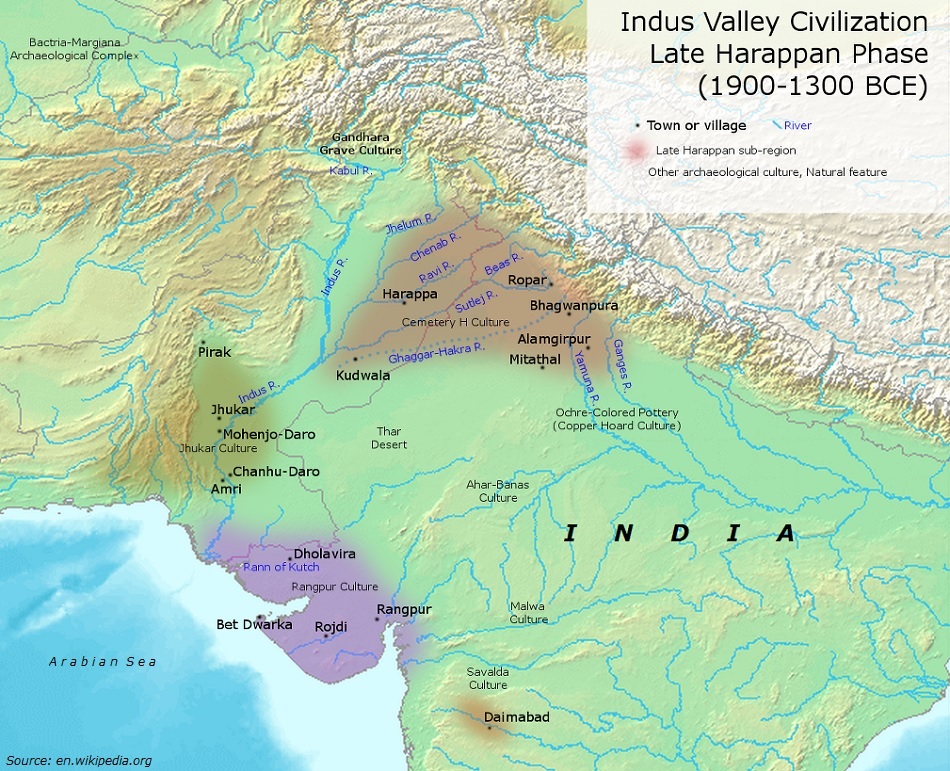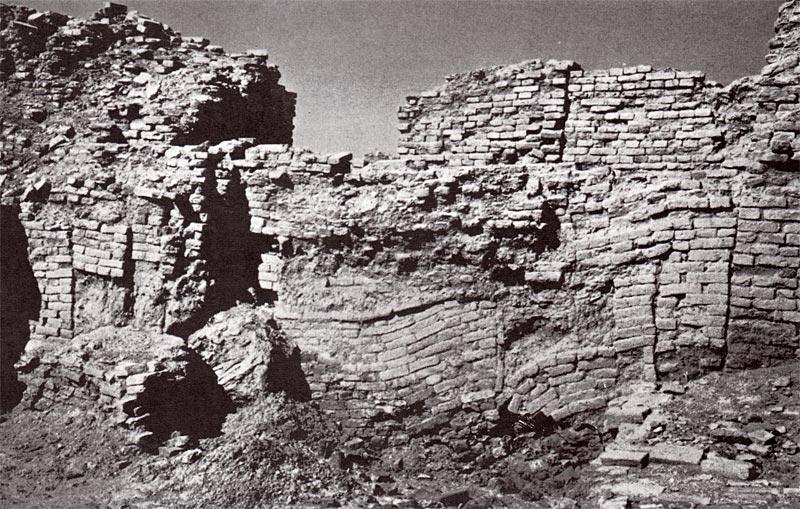After flourishing for more than 1000 years Harappan Civilization came to an end; the decline of Harappan civilization has been explained quite differently by different sections of scholars. This controversy about the decline of Harappan Civilization is the outcome of the fact that excavation carried out at various Harappan settlements have brought to light different evidence indicating decline caused by different factors. This varied evidence has been used by scholars to put forward different theories to explain the decline of this great civilization.
Theory of sudden decline due to invasion of Vedic Aryans

According to this theory, Harappan Civilization was attacked by Vedic Aryans, these Aryans came from outside, they were warlike people & they destroyed Harappan towns & cities. Harappan were massacred & civilization came to end suddenly. This theory was put forward by R.C. Mortimer wheeler, V. Gordon Childe, Stuart Piggott.
Supporting Evidence
Supporters of this theory put forward several archaeological evidence discovered during excavation at Harappan settlements & literary references found in Rigveda. The archaeological excavation carried out at Mohenjodaro discovered 37 skeletons some of these skeletons were found in streets, some were wells & 13 of these were found in one single room.
Some of this skeleton has wound marks which indicates that these people were attacked with sharp-edged weapons. These skeletons indicate that city of Mohenjo-Daro faced a sudden attack. The people were caught unaware; they were massacred while running for safety.
In Rigveda, Indra was mentioned as Purandar & Vritrahana. Purandar refers to the destroyer of fortified settlements. Vritrahana means a slayer of daemon Vritrahana this demon obstructing the flow of water in the river. This description of Vritrahana indicates it was nothing but Dams builds for flood & irrigation. The destruction of dams severely affected agriculture production. The destruction of fortified settlements brought an end to urban life. As a result of this Harappan Civilization declined suddenly.
Other views about the decline of the Harappan Civilization

According to John Marshal, S.R. Rao, the flood was responsible for the decline of Harappan Civilization. The Harappan settlement is located on river banks. They were vulnerable to floods. The city of Mohenjo-Daro was destroyed by floods no less than 7 times. According to M.R. Sahni & B.L. Rice, Harappan civilization was destroyed by Inundation caused by rising water levels. The H. cities got flooded & life in those cities came to an end.
According to M. Dmitriev, the civilization was destroyed by the physiochemical explosion. This explosion resulted in massive fire & Harappan cities got burned. Evidence of destruction by fire was discovered by him at Rakhigarhi.
According to K.V. R. Kennedy, civilization was destroyed by the Malaria epidemic. Evidence of destruction by Malaria was found by him at Mohenjodaro. According to H.T. Lambrick, civilization was destroyed by the change in course of the river. On basis of archaeological excavation carried out at Kalibangan, he found that city was destroyed due to change in course of Ghaggar.
According to D.P. Agarwal & R.K. Sood civilization was destroyed by an increase in aridity. The amount of water in the rivers got reduced. Life became non-sustainable & civilization came to end. According to Robert Raikes, the civilization was stricken by technology tonic disturbances. A massive earthquake took place in the area of Harappan Civilization that destroyed its towns & cities. Evidence of earthquakes was found at Kalibangan.
Theory of Gradual Decline due to Economic Imbalance
Recent archaeological excavation carried out but archaeologists like M. Aurel Stein, Walter A. Fariservis, Redmond & Bridge Alehin, A.N. Ghosh & Md Rafiq Mughal have revealed that the decline of the Harappan Civilization was a gradual phenomenon and economic imbalanced / climate change was primarily responsible for the decline of this great civilization.
The Harappan practiced intensive agriculture for a period of more than 1000 years as a result of which fertility of soil got reduced. The Harappan cleared forest by using fire. The burning of forests released a huge quantity of carbon dioxide in the atmosphere this resulted in the phenomenon of global warming climate change was witnessed, as a result, rainfall became erratic, floods & droughts became frequent.
The decline in fertility of the soil, erratic rainfall, frequent floods & droughts adversely affected the agriculture of Harappan people. The amount of agricultural surplus available with them got reduced. As a result of which the fine balance on which Harappan Culture was resting got disturbed. This civilization continued to flourish till, the time balance evolving agriculture surplus, arts & crafts, Trade & Commerce was intact when this balance got destruct, the proc. of the decline of Harappan Civilization commenced. This procedure of decline was strengthening further like a decline in the external & conservative outcomes of Harappan.
Role of Decline of External trade in the disappearance of Harappan Civilization
Around 1900 BC, Mesopotamia’s record stopped motioning Meluha. This indicates that Harappan trade and commerce with Mesopotamia was no longer significant after 1900 BC. Archaeological excavation carried out in Central Asia has brought to light that some ware like the group had got settled in that region in around 2000 BC.
The presence of these groups obstructed the overland, external trade of Harappan Civilization. The decline in external trade severely affected the health of Harappan cities because the inflow of foreign wealth was no longer significant & the demand for manufacturing goods got reduced. These factors made urban life unsustainable.
People had to abandoned urban centers. Many of them migrated into the western coastal region (Gujarat) where a large number of settlements emerged after 1900 BC. Many Harappan migrated into nearby villages. The abandonment of cities resulted in a decline in Harappan civilization. This proc. started in the north-west region which was dependent on external trade later on it moved into other areas of this civilization.
Role of conservative attack of Harappan
The excavation of Harappan scripts their tools & implements, the quality of bronze & pottery, etc. used by them indicates that no significant evolution took place in the life of Harappan for more than 500 years. There was a high degree of stagnation in Harappan Civilization.
Despite having close commercial relations with Mesopotamia, Harappan failed to learn the technique of making bronze of superior quality. As a result of which they could not benefit from the use of stronger material. This stagnation didn’t allow Harappan to prepare for the challenges of the future when these serious challenges emerged in front of Harappan Civilization. It failed to counter them & this great civilization came to end.
Causes of continuity
After flourishing for more than 1000 years, Harappan Civilization came to an end but all the elements and ideas of this civilization didn’t disappear. Many elements of great Harappan Civilization could be continued into – later periods of Indian history because of the terminal decline of the urban phase only. The entire human life didn’t come to end with the decline of the Harappan Civilization.
Even after the decline of the urban phase, the associated rural life continued unabatedly. Along with this rural life, many elements of Harappan Civilization could continue in the later phases of Indian History. The decline of Harappan Civilization was not the result of the annihilation of Harappan people. The cities declined because dot their abandonment by Harappan. Harappan Civilization declined when urban life was no longer sustainable.
The resident of Harappan town & cities carried their ideas, beliefs & practices with them when they migrated into nearby villages. The process of decline of the Harappan Civilization was a long-drawn-out process. It continued over a long period of over 600 years. The process of decline of the Harappan Civilization commenced around 1900 BC & at many settlements, civilization survived up to 1300 BC.
During this long period of many centuries, many elements of Harappan Civilization could assimilate with contemporary culture to continue during later periods. The process of decline of the Harappan Civilization had regional variation at first the settlement of North-West declined. The settlement of the western coastal region declined much later. This factor also facilitated the continuation of Harappan culture into later ages.

